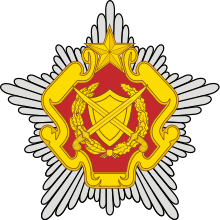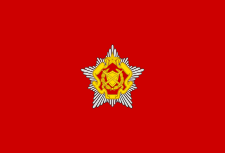
The Armed Forces of the Republic of Belarus are the military forces of Belarus. It consists of the Ground Forces and the Air Force and Air Defence Forces, all under the command of the Ministry of Defence. As a landlocked country, Belarus has no navy, however the Belarusian military does have control over some small Soviet inherited naval vessels in its rivers and lakes.
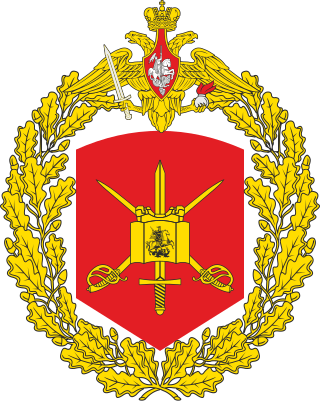
The 1st Guards Tank Army is a tank army of the Russian Ground Forces. в/ч 73621.

The Order of Lenin Moscow Military District is a military district of the Armed Forces of the Russian Federation. Originally it was a district of the Imperial Russian Army until the Russian Empire's collapse in 1917. It was then part of the Soviet Armed Forces. The district was awarded the Order of Lenin in 1968. In 2010 it was merged with the Leningrad Military District to form the new Western Military District.

The Ukrainian Ground Forces, also referred to as the Ukrainian army, are the land forces of Ukraine and one of the eight branches of the Armed Forces of Ukraine. They were formed from Ukrainian units of the Soviet Army after Ukrainian independence, and trace their ancestry to the 1917–22 army of the Ukrainian People's Republic.
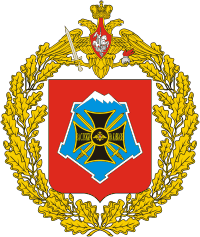
The North Caucasus Military District was a military district of the Russian Armed Forces from 1992-2010. Before 1992 it had been part of the Soviet Armed Forces since 1918. In 2010 it became the Southern Military District and lately also included the Black Sea Fleet and Caspian Flotilla.
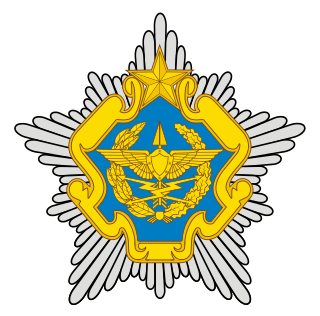
The Air Force and Air Defence Forces of the Republic of Belarus is the air force of the Armed Forces of Belarus, formed in 1992 from the 26th Air Army of the Soviet Air Forces which had been serving in the Byelorussian SSR.

The Bulgarian Land Forces are the ground warfare branch of the Bulgarian Armed Forces. It is administered by the Ministry of Defence, previously known as the Ministry of War during the Kingdom of Bulgaria. The Land Forces were established in 1878, when they were composed of anti-Ottoman militia (opalchentsi) and were the only branch of the Bulgarian military.

The 120th Guards Mechanised Brigade is a mechanised infantry brigade of the Belarus Ground Forces. It is the heir to the traditions of the Red Army 120th Guards Rifle Division which became the 120th Guards Motor Rifle Division in 1957.

The 103rd Separate Guards Airborne Brigade is an airborne brigade of the Belarusian Special Forces. Its predecessor unit was the 103rd Guards Airborne Division, which was a division of the Soviet Airborne Troops. It was established in 1946 and disbanded in 1993, a year after its transfer to the Armed Forces of Belarus. The division was formed from the 103rd Guards Rifle Division, which fought as infantry during the final months of World War II in the Vienna Offensive following its formation in late 1944.

The 51st Guards Artillery Brigade is an artillery brigade of the Belarusian Ground Forces, based at Osipovichi.

The Northwestern Operational Command (SZOK) is a command of the Belarus Ground Forces. It is headquartered at Borisov and is commanded by Major General Alexander Volfovich. The command includes a mechanized brigade and a mixed artillery brigade. It was formed in 2001 from the 65th Army Corps.
The 161st Stanislav Red Banner Order of Bohdan Khmelnytskyi Mechanised Brigade was a brigade of the Ukrainian Ground Forces from 1993 to 2003.

The Red Banner Central Asian Military District was a military district of the Soviet Armed Forces, which existed in 1926–1945 and 1969–1989, with its headquarters at Tashkent (1926–1945) and Almaty (1969–1989). By USSR Order No.304 of 4 June 1926, the Turkestan Front was renamed the Central Asian Military District.
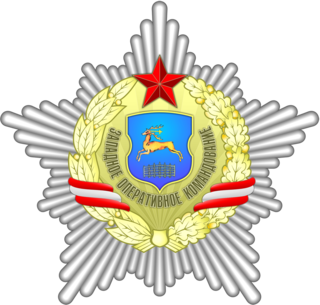
The Western Operational Command (ZOK) is a command of the Belarus Ground Forces. It is headquartered in Grodno. It is composed of two Mechanized Brigades and an artillery brigade. The command was created in 2001 from the 28th Army Corps, the former 28th Army.

The Coastal Troops are a service arm of the Russian Navy. Their missions are to protect Russian fleets' forces, personnel, and seashore objects from enemy surface ships; to defend naval bases and other important facilities of the Fleets from land attacks, including amphibious and air assaults; to participate in amphibious and air assaults; to support the Russian Ground Forces in defending against airborne and amphibious assaults; and to destroy enemy surface ships, boats and amphibious transports in their operational area.

The Troops of Radiological, Chemical and Biological Defence of the Russian Armed Forces are an organisation designed to reduce the losses of the Ground Forces and ensuring their combat tasks assigned during operations in conditions of radioactive, chemical and biological contamination, as well as at enhancing their survivability and protection against high-precision and other weapons.

The Missile Troops and Artillery, are a Combat Arm of the Russian Ground Forces, They are the primary means of providing fire on the enemy during combined-arms operations. They are designed to perform the following main tasks:

The Belarusian Transport Troops as is the service branch of the Armed Forces of Belarus. It is responsible for the movement of personnel and material by truck, rail, and air, and is designed to carry the tasks of the transport support of the military formations from other service branches across the country.

The Internal Troops of the Ministry of Internal Affairs is an Internal Troops - paramilitary law enforcement force in the Republic of Belarus under the national Ministry of Internal Affairs. All personnel are trained in the Internal Troops Faculty of the Military Academy of Belarus.

The 336th Rocket Artillery Brigade is a rocket artillery brigade of the Belarusian Ground Forces. The only rocket artillery brigade of the Armed Forces of Belarus, the brigade is armed with BM-30 Smerch multiple rocket launcher system inherited from the Soviet Union with one battalion equipped with the domestically produced Polonez multiple rocket launcher. Based at the Yuzhny military base near Osipovichi, the brigade reports directly to the General Staff of the Armed Forces of Belarus.
